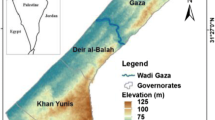Abstract
Objective assessment of irrigation water requirement is crucial for optimal allocation and management of water in irrigated agriculture. Conventional estimation of field irrigation requirement involves computation of crop water requirement to meet the evapotranspiration requirement of the crop at the field level and canal level quantities are estimated considering the losses in conveyance, distribution and application. The in-season rainfall and its intra-seasonal variations are not considered. A study was carried out in Kurnool Cuddapah Command (KCC) area to estimate field level irrigation water requirement from soil water stress coefficient (Ks) derived from water balance components estimated from a process based hydrological model. The hydrological model (Variable Infiltration Capacity Model: VIC-3L) enabled simulation of soil moisture status along the soil column under prevailing rainfall conditions. This helped in identifying intermittent wet and dry periods requiring irrigation intervention. The irrigation water requirement is estimated by adjusting/adding requisite soil water through modification of crop coefficient proportional to the water stress coefficient (Ks) which is a function of root zone depletion of water. The field level irrigation water requirement at 8 day interval has been estimated for each of the Rabi seasons spanning over a decade of 2003–2013 for KCC area. The irrigation requirement varied between 135 and 165 mm. Validation of estimated irrigation requirement is attempted through correlating gap in supply and demand with the trends in crop production during the study years. The attempted methodology provides opportunities to estimate realistic irrigation requirement and future trends under projected climate change scenarios.









Similar content being viewed by others
References
FAO (2010) FAO: AQUASTAT. On-line statistics on global map of irrigated areas. Rome, Italy. http://www.fao.org/nr/water/aquastat/irrigationmap/ind. Accessed 10 June 2017
Richard GA, Luis SP, Dirk R, Martin S (1998) FAO irrigation and drainage no. 56: crop evapotranspiration. FAO, Water Resources Development and Management Service, Italy
Brouwer C, Heibloem M (1986) FAO irrigation water management training manual no. 3. FAO Land and Water Development Division, Italy
Doll P, Seibert S (2002) Global modelling of irrigation water requirements. Water Resour Res 38:8.1–8.10
Gaurav P, Prasun G, Jyoti N (2010) Crop and irrigation water requirement estimation by remote sensing and GIS: A case study of Karnal district, Haryana, India. Int J Eng Technol 2:20.7–20.11
Surendran U, Sushanth CM, George M, Joseph EJ (2015) Modelling the crop water requirement using FAO- CROPWAT and assessment of water resource management: a case study of Palakkad district of humid tropical Kerala, India. Aquat Procedia 4:1211–1219
Surendran U, Sushanth CM, George M, Joseph EJ (2017) FAO-CROPWAT model based estimation of crop water need and appraisal of water resource management: pilot study for Kollam district- humid tropical region of Kerala. Curr Sci 112:76–85
Kuo SF, Ho HH, Liu CW (2006) Estimation irrigation water requirements with derived crop coefficients of upland and paddy crops in Chian Nan Irrigation Association Taiwan. Agric Water Manag 82:433–451
Hu X, Shi L, Zeng L, Yang J, Zha Y, Yao Y, Cao G (2016) Estimation of actual irrigation amount and its impact on groundwater depletion: acase study of Hebei Plain, China. J Hydrol 543:433–449
Water Resources Department, Govt. of Andhra Pradesh (2015) Irrigation profile of Kurnool district. On-line document on features of irrigation projects in Kurnool district in Andhra Pradesh State. http://irrigationap.cgg.gov.in. Accessed on 11 July 2017
Government of India (2015) Open Government Data Platform India. Online statistics on crop production data from 2000 to 2013 for all the districts in India. https://data.gov.in/catalog/district-wise-season-wise-crop-production-statistics. Accessed on 09 May 2017
Upadhyaya HD, Kashiwagi J, Varshney RK, Gaur PM, Saxena KB, Krishnamurthy L, Gowda GLL, Pundir RPS, Chaturvedi SK, Basu PS, Singh IP (2012) Phenotyping chickpeas and pegionpeas for adaptation to drought. Front Physiol 3:179.1–179.10
Pimpale AR, Rajankar PB, Wadatkar SB, Ramteke IK (2014) Determination of spatial crop co-efficient of chickpea using remote sensing. Am Int J Res Form Appl Nat Sci 14–349:59–65
Liang X, Lettenmaier DP, Wood EF, Burges SJ (1994) A simple hydrologically based model of land surface water and energy fluxes for GSMs. J Geophys Res 99:14.415–14.428
Huilin G, Qiuhong T, Xiaogang S et al (2009) Algorithm theoretical basis document, water budget record from variable infiltration capacity model. University of Washington, Seattle
Franchini M, Pacciani M (1991) Comparative-analysis of several conceptual rainfall runoff models. J Hydrol 122:161–219
Zhao RJ (1992) The Xinanjiang model applied in China. J Hydrol 135:371–381
Tungabhadra Board (2017) Utilization of water between 1976–77 to 2013–2014. http://tbboard.gov.in/reservoir/. Accessed on 14 July 2017
Author information
Authors and Affiliations
Corresponding author
Rights and permissions
About this article
Cite this article
Issac, A.M., Raju, P.V., Joshi, S. et al. Decadal Trends in Field Level Irrigation Water Requirement Estimated by Simulation of Soil Moisture Deficit. Proc. Natl. Acad. Sci., India, Sect. A Phys. Sci. 87, 901–910 (2017). https://doi.org/10.1007/s40010-017-0458-2
Received:
Revised:
Accepted:
Published:
Issue Date:
DOI: https://doi.org/10.1007/s40010-017-0458-2




